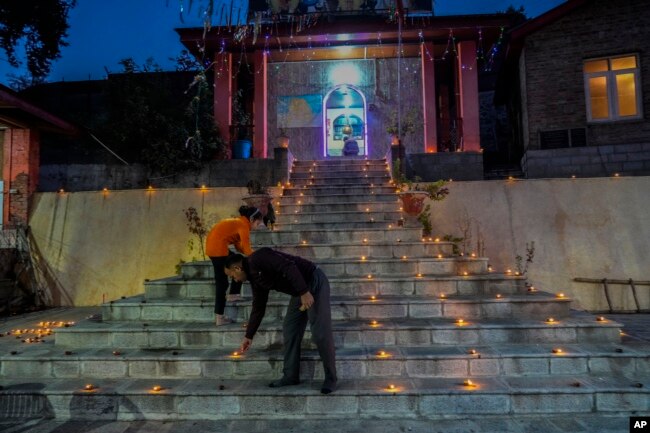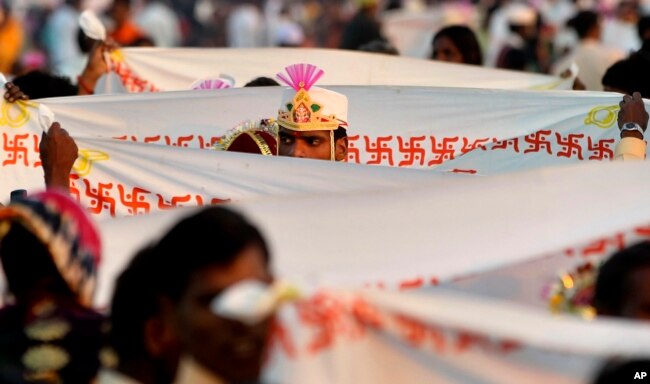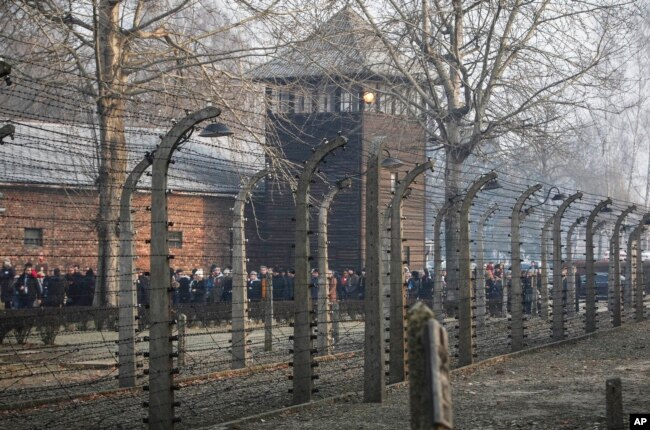鉤十字の歴史
”平和、癒し、善のシンボル ”であった鉤十字。
ナチスがこのシンボルを採用したことから、卐は幸運のシンボルからナチスの象徴へとなりました。
※ハーケンクロイツ:鉤十字のドイツ語。(ドイツ語: Hakenkreuz)
スワスティカ:鉤十字の英語(英語: swastika)
ナチスがこのシンボルを採用した経緯は、ドイツの考古学者、ハインリヒ・シュリーマンがトロイの遺跡の中で卐を発見し、卐を古代のインド・ヨーロッパ語族に共通の宗教的シンボルと見なしたためで、これに基づき、アーリアン学説のいうアーリア人の象徴として採用したようです。
私自身知りませんでした。
VOAで英語を学びましょう!!
宗教団体、戦争や憎悪に関連するシンボルの再定義を目指す(和訳)
Religious Groups Aim to Redefine Symbol Linked to War, Hatred
Dec.01,2022
シーター・デオ 博士は最近、ディワリと呼ばれるヒンズー教の光の祭典を祝ったとき、それが不快に思われるとは思いませんでした。しかし、彼女はニューヨーク市にある自分のビルの職員から、"swastika(鉤十字)卍が描かれている"という理由でディワリの飾りを取り外すようにと手紙を受け取ったのです。
鉤十字卍は両端が直角の十字架です。ヒンズー教、仏教、ジャイナ教などいくつかの文化圏で、平和と幸運のシンボルとして古くから使われてきたと考えられています。
しかし、欧米やロシアでは、鉤十字はハケンクロイツとも呼ばれ、アドルフ・ヒトラー率いるナチス・ドイツと結びつけられています。このシンボルは、第二次世界大戦中に何百万人ものユダヤ人やその他の人々が殺害されたホロコーストにも関連しています。憎悪行為と結びついているグループは、鉤十字を使い続けています。
しかし、AP通信によると、アジア系移民やネイティブアメリカンの間で、過去10年間に鉤十字の以前の意味を取り戻そうとする動きが出てきていると報告されています。
デオ氏は、これらのコミュニティは、過去に誤用されたからといって、そのシンボルを使うことを謝るべきではないと考えていると言っています。
「私にとっては、それはintolerable耐え難いことです」とデオ氏は言います。
しかし、他の多くの人々、特にユダヤ人社会では、鉤十字に2度目のチャンスを与えることは不可能です。
シェリー・ルード・ワーニック氏は、北米ユダヤ連盟のホロコースト生存者ケア・センターのディレクターです。ワーニック氏は、ホロコーストの生存者はこのシンボルを見ると、再びhorrors恐怖を感じる可能性があると述べています。彼女は、「私は鉤十字を憎しみのシンボルとして認識しています "と言い続けています。
スティーブン・ヘラー氏は、鉤十字: 贖罪を超えたシンボル? という本を書きました。彼は、鉤十字は愛する人を殺された多くの人にとって感情的なシンボルであると述べています。ヘラー氏の曾祖父はホロコーストで亡くなっています。
「ばらの花はばらの花。結局のところ、シンボルが視覚的、感情的にどのように影響するかということなのです」とヘラー氏は言っています。
他の文化における鉤十字の意味
鉤十字は先史時代から使われてきました。言葉自体は古代言語のサンスクリット語にルーツがあり、"幸福の印 "を意味します。
インドにあるジャイナ教という宗教では、鉤十字は4種類の誕生を表しています。仏教では "“manji.まんじ "と呼ばれます。仏教の寺院の目印によく使われます。中国では "Wàn ワン"と呼ばれています。
このマークはインドでよく見られます。玄関や車など、さまざまな場所で見かけます。赤と黄色で描かれているのが一般的です。
ヴィカス・ジャイン氏はオハイオ州クリーブランド市の医師です。彼と彼の妻は、子供たちの友達が訪ねてきたとき、"違いがわからないだろう "という理由で、このシンボルの画像を家に隠さなければならなりませんでした。
鉤十字はまた、世界中の多くのindigenous 先住民のコミュニティにとって重要なシンボルでした。それらは1万年以上前のものも発見されており、現在はウクライナの国立歴史博物館で見ることができます。
1900年代初頭、ネイティブアメリカンのアーティストたちは、銀細工、衣服、陶器などの工芸品にこれを使用しました。しかし、ナチスが使用した後、ホピ族、ナバホ族、アパッチ族などの指導者たちは、1940年にこのシンボルの使用を禁止する合意を承認しました。
パトリシア・アン・デイビスさんは、チョクトー族とディネー族のメンバーです。ナチスがその意味を変えるまでは、平和、癒し、善のシンボルであったと彼女は言います。今こそ、このシンボルの最初の意味を取り戻す時だと彼女は付け加えます。
鉤十字とハーケンクロイツの違い
北米ヒンズー教連合は、鉤十字とナチスのハーケンクロイツと呼ばれる”十字架”との分離を目指す団体の一つです。
この団体は、公共の場でハーケンクロイツを示すことを違法とするカリフォルニア州の新しい法律を支持しています。この法律は、神聖なシンボルとしての鉤十字を犯罪にするものではありません。しかし、どちらのシンボルも "鉤十字 "であるとしています。
ジェフ・ケルマン氏はニューハンプシャー州を拠点とするホロコーストの歴史家です。彼はハーケンクロイツと鉤十字は分離できると考えています。ケルマン氏はこの考えをユダヤ人コミュニティーに提示しています。
彼は、このシンボルが良いものとして再定義されることを期待しています。なぜなら、彼のメッセージは、ホロコーストの生存者を含む多くの人々に理解されていると思うからです。
「人々が、インド人の少女がスワスティカという名前になり、学校でbe harassed 嫌がらせを受ける可能性があることを知れば、これらを2つの別のシンボルとして見るべきことを理解するでしょう」とケルマン氏は話しています。
グレタ・エルボーゲンさんは85歳のホロコーストの生存者です。彼女の家族は第二次世界大戦中にアウシュビッツ・ビルケナウで殺害されました。彼女は、鉤十字の歴史について知って驚いたと言います。
エルボーゲンさんは、このシンボルに関する新しい情報は、彼女を怖がらせるために使われたシンボルを恐れていないことを意味すると述べています。
「鉤十字がが多くの人々にとって美しく、神聖なものであると聞いたことは、祝福に値することです。過去を手放し、未来に目を向けるときが来たのです」とエルボーゲンさんは語りました。
Religious Groups Aim to Redefine Symbol Linked to War, Hatred
When Dr. Sheetal Deo celebrated the Hindu festival of lights called Diwali recently, she did not think it would be considered offensive. But she got a letter from officials at her building in New York City telling her to remove her Diwali decorations because it “had a swastika on it.”
The swastika is a cross with right angles at the ends. It is believed to have long been used as a symbol of peace and good luck in the Hindu, Buddhist, and Jainist religions and several cultures.
In the West and Russia, however, the swastika, also called hakenkreuz, is linked to Adolf Hitler’s Nazi Germany. The symbol is also linked to the Holocaust in which millions of Jews and other people were killed during World War II. Groups tied to acts of hate have continued to use the swastika.
However, the Associated Press (AP) reports that there has been a movement to reclaim the earlier meaning of the swastika in the past 10 years among Asian immigrants and Native Americans.
Deo said she believes these communities should not apologize for using their symbol because of its misuse in the past.
"To me, that's intolerable," Deo said.
But to many others, especially in the Jewish communities, giving the swastika a second chance is not possible.
Shelley Rood Wernick is a director of the Jewish Federations of North America's Center on Holocaust Survivor Care. Wernick said Holocaust survivors could feel the horrors again when they see the symbol. She went on to say, “I recognize the swastika as a symbol of hate."
Steven Heller wrote a book called Swastika: Symbol Beyond Redemption? He said the swastika is an emotional symbol for so many whose loved ones were murdered. Heller’s great-grandfather died during the Holocaust.
“A rose by any other name is a rose. In the end, it's how a symbol affects you visually and emotionally,” Heller said.
The swastika’s meaning in other cultures
The swastika has been used since prehistoric times. The word itself has roots in Sanskrit, an ancient language, and means “the mark of well being.”
In the religion of Jainism found in India, the swastika represents four kinds of births. In Buddhism, it is called “manji.” It is often used to mark the place of Buddhist temples. And in China, it is called “Wàn.”
The symbol is common in India. It is seen in doorways, on cars, and in other places. It is usually drawn with red and yellow colors.
Vikas Jain is a doctor in the city of Cleveland, Ohio. He and his wife have had to hide images in their home with the symbol because when their children’s friends visit "they wouldn't know the difference."
The swastika was also an important symbol to many indigenous communities around the world. They can be found on objects dating back more than 10,000 years which now can be seen in the National Museum of the History of Ukraine.
In the early 1900s, Native American artists used it in their crafts, including silver work, clothes, and pottery. But after the Nazis used it, leaders of the Hopi, Navajo, Apache, and other tribes approved an agreement in 1940 to ban the symbol from use.
Patricia Anne Davis is a member of the Choctaw and Dineh nations. She said it was a symbol of peace, healing, and goodness until the Nazis changed its meaning. She added that it is time to bring back the first meaning of the symbol.
Difference between swastika and hakenkreuz
The Coalition of Hindus of North America is one of the groups aiming to separate the swastika from the Nazi’s “cross” called hakenkreuz.
The group supports a new law in the state of California that makes it illegal to show the hakenkreuz in public. The law does not criminalize the swastika as a sacred symbol. However, it says both symbols are “swastikas.”
Jeff Kelman is a Holocaust historian based in the state of New Hampshire. He believes the hakenkreuz and swastika can be separated. Kelman is presenting this idea to Jewish communities.
He is hopeful that the symbol can be redefined as a good thing because he sees his message being understood by so many people, including Holocaust survivors.
"When they learn an Indian girl could be named Swastika and she could be harassed in school, they understand how they should see these as two separate symbols,” Kelman said.
Greta Elbogen is an 85-year-old Holocaust survivor. Members of her family were killed at Auschwitz-Birkenau during World War II. She said that she was surprised to learn of the swastika’s history.
Elbogen said this new information about the symbol means she does not fear the symbol that was used to frighten her.
"Hearing that the swastika is beautiful and sacred to so many people is a blessing. It's time to let go of the past and look to the future,” Elbogen said.
Words in This Story
decoration – n. something that decorates or beautifies
symbol – n. a place, action, object, or event, that expresses or represents a particular idea or quality
faith – n. strong religious belief or strong belief in someone or something
intolerable – adj. too bad, harsh, or severe to be accepted
horror – n. an experience or thing that causes great fear or dread
indigenous – n. native to a place
harassed – v. to annoy or bother (someone) in a constant or repeated way
legacy – n. something that comes from someone in the past that affects the present
sacred — adj. greatly honored by a religion



